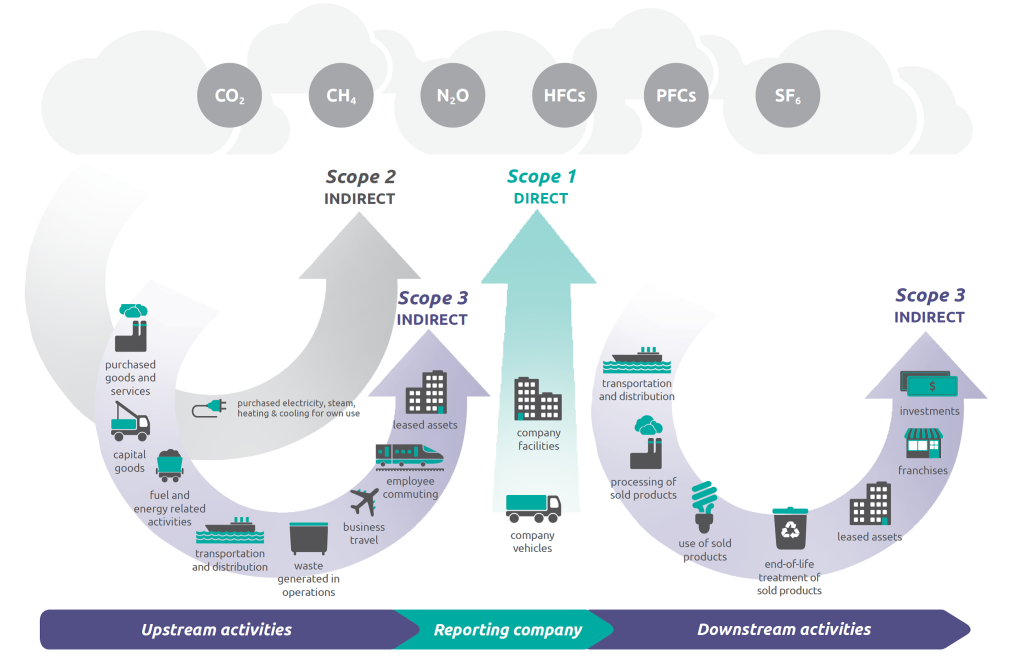Race to Net Zero – Scope Emissions Explained

The challenge of combating climate change continues to be a focus for global governments. With the UK setting a target of achieving Net Zero emissions by 2050, much will hinge on the ability of commercial real estate to reduce carbon emissions or decarbonise their assets.
The first step in this journey is understanding scope emissions and their impact on commercial properties. Then, businesses can implement energy-saving solutions to reduce their carbon footprint.
This explainer outlines scope emissions and how to reduce your commercial property’s carbon footprint.
What are scope emissions?

Scope emissions are a way of categorising the different sources of greenhouse gas (GHG) emissions a company is responsible for. They are broken down into three categories:
Scope 1: Direct Emissions:
Scope 1 emissions are directly released by your business or property. For commercial real estate, this could include emissions from on-site combustion of fuels (like gas boilers for heating) and emissions from company vehicles.
Scope 2: Indirect Emissions (Electricity):
Scope 2 emissions cover those released through electricity generated by power plants before delivery to your property. These include emissions from power stations.
Scope 3: All Other Indirect Emissions:
Meanwhile, Scope 3 emissions cover all other emissions incurred by staff, tenants, and supply chains. This includes emissions from employee commuting, delivery and logistical vehicles, and asset manufacturing.
Scope Emissions and their impact on commercial property
Emissions from commercial real estate account for a high proportion of the UK’s carbon footprint. Understanding and addressing scope emissions is not just an ethical imperative but also a business one.
Here’s why:
Over the next few years, you can expect new legislation to force commercial property owners and landlords to reduce carbon emissions. While changes could mean investing up front to ensure your building’s compliance, several benefits are available.
For example, environmental, social, and governance (ESG) factors are increasingly important for investors. Providing sustainable commercial real estate ensures your property is an attractive investment option. In addition, with most businesses boosting their sustainability focus, commercial properties with low carbon footprints will help you attract and retain tenants.
Perhaps the most compelling benefit is a reduction in operating costs. Upgrading existing systems and implementing new technologies requires significant upfront capital investment, you will realise substantial cost savings over time on your utility bills.
Energy Saving Solutions for Commercial Real Estate: Reducing Scope 1 and Scope 2 Emissions
Focusing on Scope 1 and 2 emissions is the best place to begin, many of which fall within the building owner’s control. Here’s how to begin reducing these emissions:
- Energy audits: Regular energy audits can identify areas for improving energy efficiency.
- Upgrade HVAC systems: Upgrading to high-efficiency HVAC systems and using heat pumps and air filtration systems can help improve efficiency and reduce bills.
- Implement smart building technology: IoT-enabled smart monitors improve efficiency by monitoring building occupancy, temperature, and humidity and automatically make changes.
- Use renewable energy: Installing solar panels or wind turbines to generate electricity can reduce your bills.
Tackling Scope 3 emissions: The Challenge for commercial real estate
Meanwhile, tackling Scope 3 emissions remains the biggest challenge for any commercial landlord. While you can directly influence Scope 1 and 2 emissions, cutting Scope 3 outputs requires buy-in from external stakeholders. Consider the following strategies to help:
- Engage your tenants: Encourage your tenants to reduce their energy consumption. Consider offering discounts for tenants displaying sustainable energy use.
- Use sustainable suppliers: Prioritise working with suppliers committed to sustainable practices.
- Employee schemes: Offer employees incentives for eco-friendly commuting. For example, subsidies for public transport usage or cycle-to-work schemes can be offered.
- Sustainable construction: Use sustainable and low-carbon building materials during building and renovation works.
- Recycle: Use recycling bins to encourage tenants and employees to recycle as much waste as possible.
The Future of Commercial Real Estate: Achieving Net Zero with Innovation
Innovation and new technologies will be key in helping commercial real estate achieve Net Zero by 2050, and acting now is critical.
For example, seeking green building certifications, such as BREEAM and LEED, is an excellent way of demonstrating your commitment to sustainability and energy efficiency. Similarly, embracing circular economy principles, recycling and reusing materials and equipment, helps you reduce waste.
However,Innovative technologies and cost-effective retrofits, such as Rensair’s range of smart solutions, are likely to have the greatest impact. Rensair’s Smart Demand Controlled Ventilation (SDCV) solution, for instance, reduces energy consumption by at least 40%, while the indoor air quality is maximised.
Add smart usage of data analytics to assess energy consumption and inform sustainability-focused decision-making, and making your commercial property carbon neutral is within reach.
Conclusion: The path to Net Zero in commercial real estate
Achieving carbon neutrality is challenging, and understanding the difference between Scope emissions is the ideal place to start. Knowing where to focus your sustainable activities will help you create an energy-efficient property for staff and tenants while helping you achieve significant cost savings in the short, medium, and long term.To learn how we can help you reduce scope emissions and achieve your Net Zero goals, contact us today and see how our innovative air filtration solutions can improve your building’s energy efficiency.
